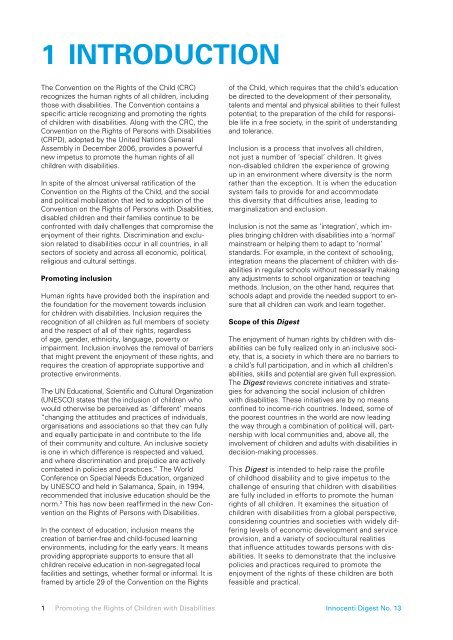Promoting the Rights of Children with Disabilities, UNICEF
Promoting the Rights of Children with Disabilities, UNICEF
Promoting the Rights of Children with Disabilities, UNICEF
- No tags were found...
You also want an ePaper? Increase the reach of your titles
YUMPU automatically turns print PDFs into web optimized ePapers that Google loves.
1 INTRODUCTIONThe Convention on <strong>the</strong> <strong>Rights</strong> <strong>of</strong> <strong>the</strong> Child (CRC)recognizes <strong>the</strong> human rights <strong>of</strong> all children, includingthose <strong>with</strong> disabilities. The Convention contains aspecific article recognizing and promoting <strong>the</strong> rights<strong>of</strong> children <strong>with</strong> disabilities. Along <strong>with</strong> <strong>the</strong> CRC, <strong>the</strong>Convention on <strong>the</strong> <strong>Rights</strong> <strong>of</strong> Persons <strong>with</strong> <strong>Disabilities</strong>(CRPD), adopted by <strong>the</strong> United Nations GeneralAssembly in December 2006, provides a powerfulnew impetus to promote <strong>the</strong> human rights <strong>of</strong> allchildren <strong>with</strong> disabilities.In spite <strong>of</strong> <strong>the</strong> almost universal ratification <strong>of</strong> <strong>the</strong>Convention on <strong>the</strong> <strong>Rights</strong> <strong>of</strong> <strong>the</strong> Child, and <strong>the</strong> socialand political mobilization that led to adoption <strong>of</strong> <strong>the</strong>Convention on <strong>the</strong> <strong>Rights</strong> <strong>of</strong> Persons <strong>with</strong> <strong>Disabilities</strong>,disabled children and <strong>the</strong>ir families continue to beconfronted <strong>with</strong> daily challenges that compromise <strong>the</strong>enjoyment <strong>of</strong> <strong>the</strong>ir rights. Discrimination and exclusionrelated to disabilities occur in all countries, in allsectors <strong>of</strong> society and across all economic, political,religious and cultural settings.<strong>Promoting</strong> inclusionHuman rights have provided both <strong>the</strong> inspiration and<strong>the</strong> foundation for <strong>the</strong> movement towards inclusionfor children <strong>with</strong> disabilities. Inclusion requires <strong>the</strong>recognition <strong>of</strong> all children as full members <strong>of</strong> societyand <strong>the</strong> respect <strong>of</strong> all <strong>of</strong> <strong>the</strong>ir rights, regardless<strong>of</strong> age, gender, ethnicity, language, poverty orimpairment. Inclusion involves <strong>the</strong> removal <strong>of</strong> barriersthat might prevent <strong>the</strong> enjoyment <strong>of</strong> <strong>the</strong>se rights, andrequires <strong>the</strong> creation <strong>of</strong> appropriate supportive andprotective environments.The UN Educational, Scientific and Cultural Organization(UNESCO) states that <strong>the</strong> inclusion <strong>of</strong> children whowould o<strong>the</strong>rwise be perceived as ’different’ means“changing <strong>the</strong> attitudes and practices <strong>of</strong> individuals,organisations and associations so that <strong>the</strong>y can fullyand equally participate in and contribute to <strong>the</strong> life<strong>of</strong> <strong>the</strong>ir community and culture. An inclusive societyis one in which difference is respected and valued,and where discrimination and prejudice are activelycombated in policies and practices.” The WorldConference on Special Needs Education, organizedby UNESCO and held in Salamanca, Spain, in 1994,recommended that inclusive education should be <strong>the</strong>norm. 2 This has now been reaffirmed in <strong>the</strong> new Conventionon <strong>the</strong> <strong>Rights</strong> <strong>of</strong> Persons <strong>with</strong> <strong>Disabilities</strong>.In <strong>the</strong> context <strong>of</strong> education, inclusion means <strong>the</strong>creation <strong>of</strong> barrier-free and child-focused learningenvironments, including for <strong>the</strong> early years. It meansproviding appropriate supports to ensure that allchildren receive education in non-segregated localfacilities and settings, whe<strong>the</strong>r formal or informal. It isframed by article 29 <strong>of</strong> <strong>the</strong> Convention on <strong>the</strong> <strong>Rights</strong><strong>of</strong> <strong>the</strong> Child, which requires that <strong>the</strong> child’s educationbe directed to <strong>the</strong> development <strong>of</strong> <strong>the</strong>ir personality,talents and mental and physical abilities to <strong>the</strong>ir fullestpotential; to <strong>the</strong> preparation <strong>of</strong> <strong>the</strong> child for responsiblelife in a free society, in <strong>the</strong> spirit <strong>of</strong> understandingand tolerance.Inclusion is a process that involves all children,not just a number <strong>of</strong> ’special’ children. It givesnon-disabled children <strong>the</strong> experience <strong>of</strong> growingup in an environment where diversity is <strong>the</strong> normra<strong>the</strong>r than <strong>the</strong> exception. It is when <strong>the</strong> educationsystem fails to provide for and accommodatethis diversity that difficulties arise, leading tomarginalization and exclusion.Inclusion is not <strong>the</strong> same as ’integration’, which impliesbringing children <strong>with</strong> disabilities into a ’normal’mainstream or helping <strong>the</strong>m to adapt to ’normal’standards. For example, in <strong>the</strong> context <strong>of</strong> schooling,integration means <strong>the</strong> placement <strong>of</strong> children <strong>with</strong> disabilitiesin regular schools <strong>with</strong>out necessarily makingany adjustments to school organization or teachingmethods. Inclusion, on <strong>the</strong> o<strong>the</strong>r hand, requires thatschools adapt and provide <strong>the</strong> needed support to ensurethat all children can work and learn toge<strong>the</strong>r.Scope <strong>of</strong> this DigestThe enjoyment <strong>of</strong> human rights by children <strong>with</strong> disabilitiescan be fully realized only in an inclusive society,that is, a society in which <strong>the</strong>re are no barriers toa child’s full participation, and in which all children’sabilities, skills and potential are given full expression.The Digest reviews concrete initiatives and strategiesfor advancing <strong>the</strong> social inclusion <strong>of</strong> children<strong>with</strong> disabilities. These initiatives are by no meansconfined to income-rich countries. Indeed, some <strong>of</strong><strong>the</strong> poorest countries in <strong>the</strong> world are now leading<strong>the</strong> way through a combination <strong>of</strong> political will, partnership<strong>with</strong> local communities and, above all, <strong>the</strong>involvement <strong>of</strong> children and adults <strong>with</strong> disabilities indecision-making processes.This Digest is intended to help raise <strong>the</strong> pr<strong>of</strong>ile<strong>of</strong> childhood disability and to give impetus to <strong>the</strong>challenge <strong>of</strong> ensuring that children <strong>with</strong> disabilitiesare fully included in efforts to promote <strong>the</strong> humanrights <strong>of</strong> all children. It examines <strong>the</strong> situation <strong>of</strong>children <strong>with</strong> disabilities from a global perspective,considering countries and societies <strong>with</strong> widely differinglevels <strong>of</strong> economic development and serviceprovision, and a variety <strong>of</strong> sociocultural realitiesthat influence attitudes towards persons <strong>with</strong> disabilities.It seeks to demonstrate that <strong>the</strong> inclusivepolicies and practices required to promote <strong>the</strong>enjoyment <strong>of</strong> <strong>the</strong> rights <strong>of</strong> <strong>the</strong>se children are bothfeasible and practical.1 <strong>Promoting</strong> <strong>the</strong> <strong>Rights</strong> <strong>of</strong> <strong>Children</strong> <strong>with</strong> <strong>Disabilities</strong> Innocenti Digest No. 13
















